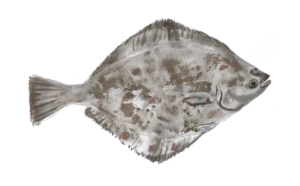The black grouper is one of the best known fishes of this group. Some of the other common names include marbled rockfish or black rockfish. This large marine fish can grow up to five feet in length and weigh up to 220 pounds. The body is gray or olive with brassy spots and black blotches. They also have a bucket-sized mouth with large powerful fins. In the blink of an eye, their mouth is capable of sucking up their prey. It is a solitary fish and the adults mainly feed on squid and other fish. The younger fish feed on crustaceans, especially shrimp. They can live up to 40 years of age.
Where to Find a Black Grouper
The black grouper is associated with coral or rocky reefs but does depend on them to live. Generally, you will find them in the western Atlantic Ocean, from southern Brazil north to the United States in Massachusetts. It is particularly associated with the Florida Keys, the Caribbean, southern Gulf of Mexico, and the Bahamas. At the northern extremes of the range you will not find any adults. You will generally find them from about 30 feet of water out to the deepest drop-off.
Learn more about the habitat of the Black Grouper at Florida Sports Man.
How to Catch a Black Grouper
The black grouper is a bottom dweller so you would catch it by bottom fishing. There are several ways in which you can catch this large fish. When fishing for black grouper, you can use jigs that are tipped with dead bait or large live baits as you play the deeper wrecks and reefs where you will often find them. The smaller black grouper will sometimes get themselves under outcroppings and coral ledges. When the black grouper takes the bait, you have to have fast reflexes because once they strike they will make a fast dash back to the nearest hole.
Best Bait, Lures & Tackle for Black Grouper
The best bait to use for catching the black grouper is google eyes or big plugs. When you use heavy jigging tackle, it will give you a chance of pulling them out from their lairs. You should use an 80 pound braided line affixed to 80 or 100 pound bullbuster monofilament. When you work with live baits and large jigs near their haunts, you have to be prepared to muscle the grouper quickly out and away.
Trolling large deep diving plugs and ballyhoo have managed to get these fish to leave the safety of their lairs to track the bait. Keep trolling them until you can get them far enough from their lair before they strike at the bait and you can reel them in.
Black grouper is a fish that will eat almost everything from dead bait to live bait to crabs. They are not picky but sometimes dead bait will not work. Many times the dead bait will lead to catching eels and sharks instead. The grouper loves nervous, commotion big baits. Just make sure that whatever bait you use, it is presented just above the bottom. The tackle needs to be heavy duty if you are going to take them from the reefs. You want to use a reel that is capable of putting out 20+ pounds of drag at minimum. Use a braided line that is at least 80 pounds with a 100 pound leader. You can use fluorocarbon or monofilament. The hooks need to match the size of the bait but the best one would be a large circle hook.
When you place your bait, such as cigar minnows, how you put it on is critical. Make sure that you do not hook it too deep. If the bait has tough skin, hook it lightly and have most of the gap of the hook exposed. This will help the hook to penetrate when the black grouper takes the bait.
How to Cook Black Grouper
There are many ways in which to cook black grouper. One way to do this is to sauté them. Over a high heat, heat 3 tablespoons of olive oil in a skillet. Season the fillets with pepper and coarse salt. Sauté the fillets, skin side down for two minutes and then turn them over, sauté them for another three minutes. They will be ready to eat when they are easily flaked with a fork and are opaque all the way through. You can serve them as is or top them with a sweet mango or spicy salsa.
Black grouper has a very unique texture and a mild taste. No matter how you fix black grouper, make sure that you start it out by cooking it skin side down.
Black Grouper Reproduction
The black grouper spawn between May and August over the reef bottom between 30-120 feet of water. It is considered a protogynous hermaphrodite, which means that the young are primarily females but as they grow larger, they transform into males. This usually happens between 11 and 14 years of old, or two to four feet in length. Their eggs are externally fertilized and float with the current.
Fun Facts about a Black Grouper
- The only real predator of the black grouper is sharks.
- A black grouper does not have teeth so that is why they have to use their mouth to suck up their prey.
- Inside their throat there are teeth plates that prevent their prey from escaping after they have been swallowed.
- Moray eels and other grouper prey upon the smaller groupers and other fish.
Conclusion
The black grouper is a very tasty fish. It is fished for sport and to sell. On the IUCN Red List, it is a near threatened species. What this means is that it is vulnerable to increases in exploitation. This is because it is a relatively slow breeder. The black grouper, from the smaller ones at 20-30 pounds up to the ones that weigh 220 pounds will give even the most hard core fisherman a physically draining fight that can be fun. If you want an exciting fishing experience, fish for black grouper.
Interested in catching other fish? Check out: How to Catch a Leatherjacket



